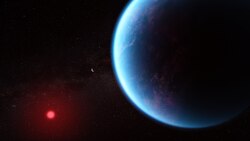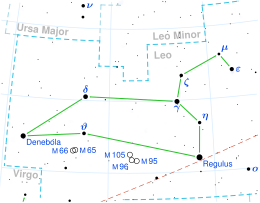K2-18, also known as EPIC 201912552, is a red dwarf star with two planetary companions located 124 light-years (38 parsecs)[4] from Earth, in the constellation of Leo.
Approximate two-dimensional location of the star (in red circle); Sigma Leonis is the nearest bright star, which is in a southerly direction, and the boundary of Virgo is similarly far. | |
| Observation data Epoch J2000.0 Equinox J2000.0 | |
|---|---|
| Constellation | Leo |
| Right ascension | 11h 30m 14.51774s[1] |
| Declination | +07° 35′ 18.2553″[1] |
| Apparent magnitude (V) | 13.50[2] |
| Characteristics | |
| Evolutionary stage | Red dwarf |
| Spectral type | M2.8[3] |
| Astrometry | |
| Radial velocity (Rv) | 0.02±0.52[1] km/s |
| Proper motion (μ) | RA: −80.479 mas/yr[1] Dec.: −133.007 mas/yr[1] |
| Parallax (π) | 26.2469 ± 0.0266 mas[1] |
| Distance | 124.3 ± 0.1 ly (38.10 ± 0.04 pc) |
| Details | |
| Mass | 0.495±0.004[4] M☉ |
| Radius | 0.469±0.010[4] R☉ |
| Luminosity | 0.0234[5] L☉ |
| Temperature | 3,503±60[4] K |
| Metallicity [Fe/H] | 0.123±0.157[6] dex |
| Rotation | 39.6±0.9 d[7] |
| Age | 2.4±0.6[7] Gyr |
| Other designations | |
| Database references | |
| SIMBAD | data |
Its name is due to the fact that it was discovered by the K2 Mission, which extended the mission of the Kepler Space Telescope after failure of two of its reaction wheels.
Planetary system
The star has a transiting exoplanet, called K2-18b, a super-Earth located within the habitable zone of K2-18.[9][10] It was discovered in 2015 by the Kepler space telescope in its K2 mission.[3] It is the first exoplanet in the habitable zone, albeit a hydrogen-rich sub-Neptune,[11] to have its atmosphere characterized; initially thought to contain water vapor,[12] more recent observations have instead detected methane and carbon dioxide.[13] The presence of these molecules and non-detection of ammonia is consistent with predictions for a hycean planet.[13]
A second, non-transiting planet, K2-18c, was discovered in 2017 by radial velocity with HARPS.[14] This planet was challenged by another team with CARMENES data,[15] but its existence was reaffirmed by the discovery team based on both HARPS and CARMENES data.[4] This planet has also been confirmed by a later independent study.[16] System tidal simulation suggests that K2-18c is a gas-rich, Neptune-like planet, similar to K2-18b.[17]
| Companion (in order from star) | Mass | Semimajor axis (AU) | Orbital period (days) | Eccentricity | Inclination | Radius |
|---|---|---|---|---|---|---|
| c | ≥5.62±0.84 M🜨 | 0.0670 ± 0.0002 | 9.2072±0.0065[16] | <0.2 | — | — |
| b | 8.63±1.35 M🜨 | 0.1591±0.0004 | 32.94488±0.00281 | — | — | 2.711±0.065 R🜨 |

